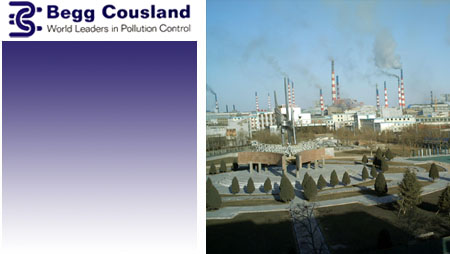






Begg Cousland's Filtration Technology
Begg, Cousland have over 50 years of experience in the design, manufacturing and installation of filters for removal of liquid particles from gas flows.
The techniques required to ensure we meet the guaranteed efficiency and pressure drop, as well as achieving the maximum filter life, enables us to design and offer you the optimum filter solution for your needs.
Detailed knowledge in-house means we understand well the industrial processes and their differing requirements.
Let us give you the benefit of our experience, guarantees, and maximised filter life.
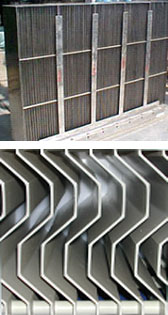 'BECOVANE' Chevron Droplet Separators.
'BECOVANE' Chevron Droplet Separators.
Duty: Removal of mechanically generated droplets using various design options
Typical Applications:
• Gas Scrubbers
• Reactor Tanks
Typical Industries:
• P Fertilisers
• Oil Refinery
• (Petro)chemicals
Typical Materials:
• Stainless Steel
• Polypropylene
• PVDF
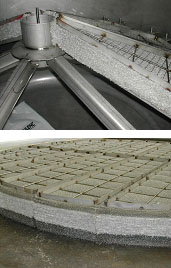 'BECONE' Coalescers
'BECONE' Coalescers
Duty: Removal of mist particles, in co-knitted fibre + demister mesh
Typical Applications:
• Drying Towers
• Prefilters
Typical Industries:
• Sulphuric Acid
• (Petro)chemicals
Typical Materials:
• Stainless Steel + Glass
• Polypropylene
• PTFE / ETFE
'BECOFLEX' Rotary Brush Scrubber
A universal and integrated scrubber system to remove solids (coarse or fine), to abate liquid particles (aerosols or droplets), and to scrub noxious gas present in any industrial gas flow.
Basic Principles
The 'BECOFLEX' principle of operation is a wetted fibre brush rotating at high speed in a special volute fan casing, thus creating an extremely dynamic gas contact.
Particles in the dirty exhaust gas stream are drawn into the unit by the suction generated by the rotary brush, and they impact at high speed with the spinning brush fibres and become thoroughly wetted. The next effect is for the particles to be centrifugally washed off, to impact on the wetted inner surface of the volute.
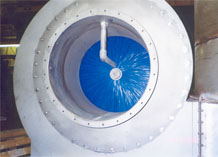 The resulting slurry is then propelled along the bottom of the exit duct to the disengagement vessel, where it falls by gravity to the bottom for removal or recirculation.
The resulting slurry is then propelled along the bottom of the exit duct to the disengagement vessel, where it falls by gravity to the bottom for removal or recirculation.
The cleaned (wet) gas meanwhile flows upwards from the duct into the disengagement vessel and towards the top gas exit. Usually a 'Becoil' demister is fitted to remove any entrained liquid droplets.
The BECOFLEX system is compact and acts as its own air mover. This usually means there is no need for a separate fan, but in some cases a secondary or main fan is also used, particularly with long upstream processes.
In comparison with the power consumption of a conventional fan, the BECOFLEX will draw up to 60% volume flow for the same power.
The BECOFLEX was invented by I.C.I. in the UK, and Begg, Cousland became a licensee at the end of the 1980s. Begg, Cousland now owns the technology.
The technology is beautifully simple, which appeals to all engineers. Often when it is presented engineers can usually imagine at least one application where it could solve a problem. That is many times the key benefit of BECOFLEX - it is a SCRUBBING PROBLEM SOLVER.
Alternative gas scrubbing technologies' disadvantages :
Packed Towers have random or structured packing, which block relatively easily with any solids in the gas.
Wet Cyclones have medium efficiency only on smaller particle sizes. Also large liquid volumes are required.
Dry Cyclones have medium efficiency only on solids, and poor efficiency on smaller particle sizes.
Venturis are very efficient, but have high energy requirement, high capital cost and high liquid volume.
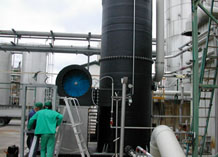 BECOFLEX's main benefits are:
BECOFLEX's main benefits are:
• It is a self-cleaning wet gas scrubber, where the gas or air impacts on the spinning brush, which is sprayed with low volume liquid. This dynamic action gives excellent gas/liquid contact and means the unit can be very compact.
• It can handle solids removal with less liquid in & effluent than conventional towers or wet cyclones.
• It can use water or any chemical solution for gas absorbtion or odour control.
• It can be fitted with packings or other 2nd stage equipment for more complex gas absorbtion duty ( the 1st stage brush having removed any solids blockage risk ).
• It acts as its own air moving fan as the brush creates more than just the suction to overcome its own pressure loss, so not only is no separate fan required, it also means it is usually easy to retrofit it to existing process lines.
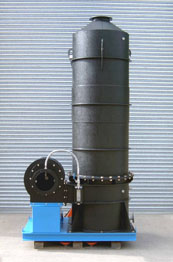 • It can act as a solids removal pre-filter in front of, and protecting mist eliminators.
• It can act as a solids removal pre-filter in front of, and protecting mist eliminators.
BECOFLEX Design Options Here we show the main 5 Design options for the BECOFLEX Technology. A Standard design BF, combinations with sprays and different types of contact bed BFA / BFC / BFP, and a combination with mist eliminators BFCF.
BECOFLEX BF Units Flow / Suction Options The Table below shows the Flow rate options for each BECOFLEX BF Unit, at 3 different Fan Static Pressure (Suction) values.
A PROFILE OF FILTRATION EXPERTS
With a history now spanning 150 years, Begg Cousland continues to provide the personal service that makes it unique.
In the industrial filtration field, experience is very important, and at Begg Cousland it is allied to a determination to continue to provide the high quality of product with which the Begg Cousland name is synonymous.
Begg Cousland have been making knitted wire demisters since the 1950s, and fibre bed type candle filter mist eliminators since the late 1960s. No other company was manufacturing both products until more than a decade later.
A deep knowledge of the materials and a consistent manufacturing process are key factors in providing a genuinely quality product. We offer that assurance and a full back-up service of experienced technical experts.
MIST ELIMINATORS & DROPLET SEPARATION FILTERS
The role of droplet separators, demisters or mist eliminators is to remove a liquid from an air or gas flow using mechanical collection by surface or filaments. The liquid may be a pollutant or, like water, be per se benign, but in either case it is contaminating the air or gas. The separation of the liquid from the air or gas within a process may :
• prevent contamination of the process
• prevent damage to, or corrosion of, downstream equipment
• recover a useful product
• prevent undesirable atmospheric emissions
Partner Company URL: www.beggcousland.com
Begg, Cousland have over 50 years of experience in the design, manufacturing and installation of filters for removal of liquid particles from gas flows.
The techniques required to ensure we meet the guaranteed efficiency and pressure drop, as well as achieving the maximum filter life, enables us to design and offer you the optimum filter solution for your needs.
Detailed knowledge in-house means we understand well the industrial processes and their differing requirements.
Let us give you the benefit of our experience, guarantees, and maximised filter life.

Duty: Removal of mechanically generated droplets using various design options
Typical Applications:
• Gas Scrubbers
• Reactor Tanks
Typical Industries:
• P Fertilisers
• Oil Refinery
• (Petro)chemicals
Typical Materials:
• Stainless Steel
• Polypropylene
• PVDF

Duty: Removal of mist particles, in co-knitted fibre + demister mesh
Typical Applications:
• Drying Towers
• Prefilters
Typical Industries:
• Sulphuric Acid
• (Petro)chemicals
Typical Materials:
• Stainless Steel + Glass
• Polypropylene
• PTFE / ETFE
'BECOFLEX' Rotary Brush Scrubber
A universal and integrated scrubber system to remove solids (coarse or fine), to abate liquid particles (aerosols or droplets), and to scrub noxious gas present in any industrial gas flow.
Basic Principles
The 'BECOFLEX' principle of operation is a wetted fibre brush rotating at high speed in a special volute fan casing, thus creating an extremely dynamic gas contact.
Particles in the dirty exhaust gas stream are drawn into the unit by the suction generated by the rotary brush, and they impact at high speed with the spinning brush fibres and become thoroughly wetted. The next effect is for the particles to be centrifugally washed off, to impact on the wetted inner surface of the volute.

The cleaned (wet) gas meanwhile flows upwards from the duct into the disengagement vessel and towards the top gas exit. Usually a 'Becoil' demister is fitted to remove any entrained liquid droplets.
The BECOFLEX system is compact and acts as its own air mover. This usually means there is no need for a separate fan, but in some cases a secondary or main fan is also used, particularly with long upstream processes.
In comparison with the power consumption of a conventional fan, the BECOFLEX will draw up to 60% volume flow for the same power.
The BECOFLEX was invented by I.C.I. in the UK, and Begg, Cousland became a licensee at the end of the 1980s. Begg, Cousland now owns the technology.
The technology is beautifully simple, which appeals to all engineers. Often when it is presented engineers can usually imagine at least one application where it could solve a problem. That is many times the key benefit of BECOFLEX - it is a SCRUBBING PROBLEM SOLVER.
Alternative gas scrubbing technologies' disadvantages :
Packed Towers have random or structured packing, which block relatively easily with any solids in the gas.
Wet Cyclones have medium efficiency only on smaller particle sizes. Also large liquid volumes are required.
Dry Cyclones have medium efficiency only on solids, and poor efficiency on smaller particle sizes.
Venturis are very efficient, but have high energy requirement, high capital cost and high liquid volume.

• It is a self-cleaning wet gas scrubber, where the gas or air impacts on the spinning brush, which is sprayed with low volume liquid. This dynamic action gives excellent gas/liquid contact and means the unit can be very compact.
• It can handle solids removal with less liquid in & effluent than conventional towers or wet cyclones.
• It can use water or any chemical solution for gas absorbtion or odour control.
• It can be fitted with packings or other 2nd stage equipment for more complex gas absorbtion duty ( the 1st stage brush having removed any solids blockage risk ).
• It acts as its own air moving fan as the brush creates more than just the suction to overcome its own pressure loss, so not only is no separate fan required, it also means it is usually easy to retrofit it to existing process lines.

BECOFLEX Design Options Here we show the main 5 Design options for the BECOFLEX Technology. A Standard design BF, combinations with sprays and different types of contact bed BFA / BFC / BFP, and a combination with mist eliminators BFCF.
BECOFLEX BF Units Flow / Suction Options The Table below shows the Flow rate options for each BECOFLEX BF Unit, at 3 different Fan Static Pressure (Suction) values.
A PROFILE OF FILTRATION EXPERTS
With a history now spanning 150 years, Begg Cousland continues to provide the personal service that makes it unique.
In the industrial filtration field, experience is very important, and at Begg Cousland it is allied to a determination to continue to provide the high quality of product with which the Begg Cousland name is synonymous.
Begg Cousland have been making knitted wire demisters since the 1950s, and fibre bed type candle filter mist eliminators since the late 1960s. No other company was manufacturing both products until more than a decade later.
A deep knowledge of the materials and a consistent manufacturing process are key factors in providing a genuinely quality product. We offer that assurance and a full back-up service of experienced technical experts.
MIST ELIMINATORS & DROPLET SEPARATION FILTERS
The role of droplet separators, demisters or mist eliminators is to remove a liquid from an air or gas flow using mechanical collection by surface or filaments. The liquid may be a pollutant or, like water, be per se benign, but in either case it is contaminating the air or gas. The separation of the liquid from the air or gas within a process may :
• prevent contamination of the process
• prevent damage to, or corrosion of, downstream equipment
• recover a useful product
• prevent undesirable atmospheric emissions
Partner Company URL: www.beggcousland.com
